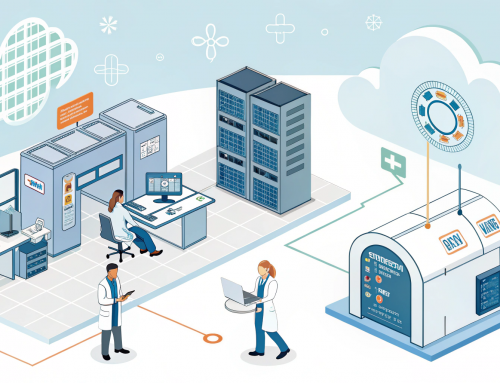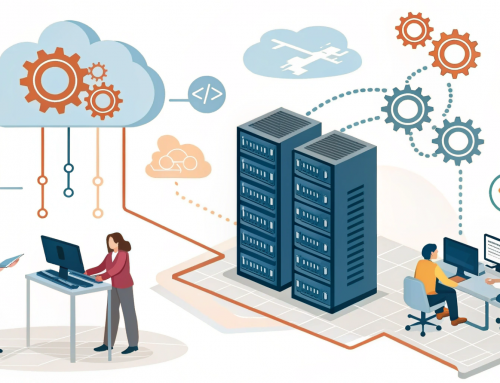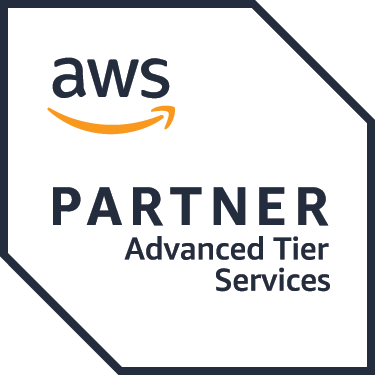This case study covers the AWS DevOps transformation of a global automotive manufacturer’s legacy Retailer Report Portal, focusing on application modernization, infrastructure-as-code implementation, and CI/CD automation. The transformation replaced a monolithic Java 8/Struts application with a modern microservices architecture, reducing deployment times, eliminating manual processes, and enabling seamless scaling for the company’s critical business reporting system used by retailers worldwide.
Client Overview:
This premium automotive manufacturer operates a critical Retailer Report Portal (RRP) that enables business units to publish reports for internal staff and global retail partners. The platform processes over 3.8 million report requests monthly, with peak volumes of 172,000 daily transactions during quarter-end periods. The system manages 8,400+ unique reports across 27 business categories and serves 32,000+ active users worldwide. With an average of €18.7 million in daily sales decisions influenced by these reports, the portal’s reliability directly impacts dealership operations and financial performance. The legacy system was consuming 76 internal IT support tickets weekly and requiring frequent maintenance windows that disrupted global operations.
Business Challenge
The client’s legacy Retailer Report Portal, built on outdated technology, created significant operational constraints that impeded their digital transformation goals.
- Outdated Technology Stack: Java 8, Struts, JSP, and Oracle DB architecture resulted in 27 security vulnerabilities and 12+ hours of weekly maintenance overhead
- Manual Infrastructure Provisioning: Environment setup required 42 manual steps and took 3-5 days, with a 23% error rate across development stages
- Poor Scalability: During peak periods, the portal experienced 78% CPU utilization with only 1,500 concurrent users, resulting in 8 major outages in the previous year
- Lack of DevOps Automation: Manual deployments took 4-6 hours each, with a 32% failure rate and average rollback time of 3.5 hours
- Performance Bottlenecks: Average page load time of 7.2 seconds and transaction processing delays of up to 12 seconds during peak hours, causing 31% of users to abandon reports
- UI Modernization Challenges: Legacy JSP frontend had 64% mobile incompatibility and maintained 17 different UI variations across global regions
- Database Limitations: On-premises Oracle database with $437,000 annual licensing costs and regular performance degradation when exceeding 10TB of report data
Challenge:
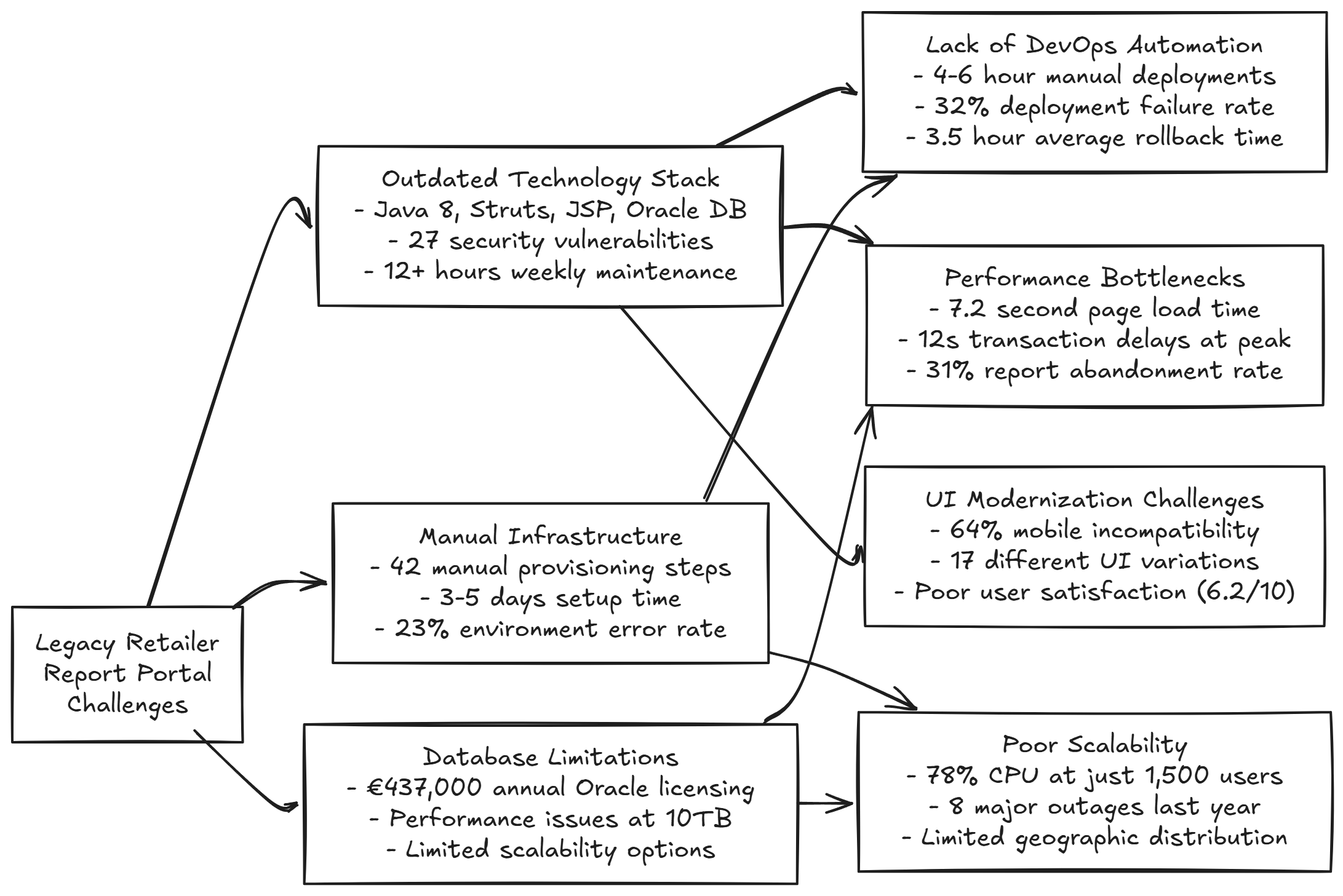
Implementation Plan:
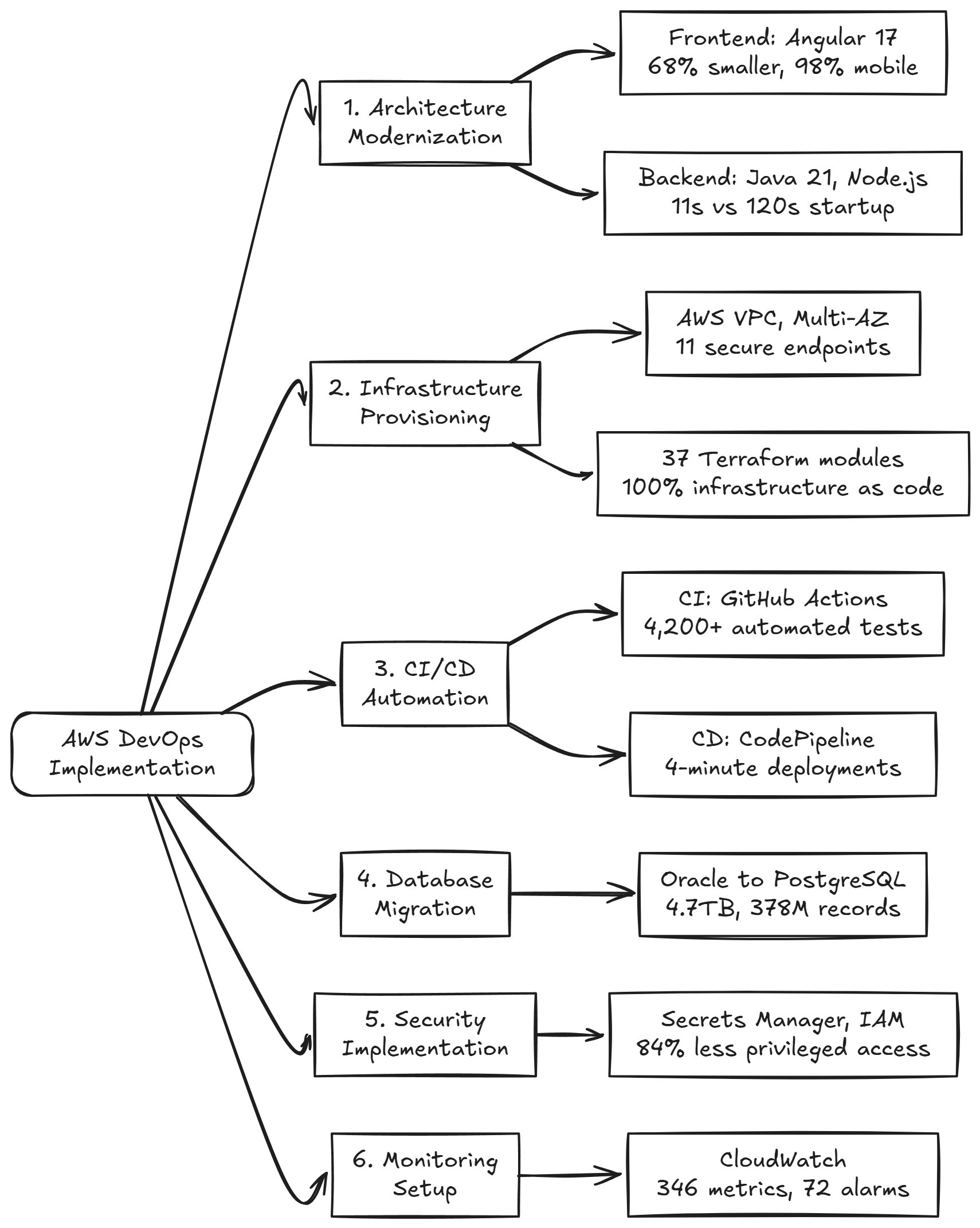
- Architecture Modernization: Design a completely revamped architecture transitioning from monolithic Struts/JSP to modern microservices using Angular 17 for frontend, Java 21 with Quarkus and Node.js for backend services
- Infrastructure as Code: Implement Terraform and AWS CloudFormation with dedicated GitHub repositories for consistent infrastructure provisioning across environments
- CI/CD Pipeline Creation: Build automated workflows using GitHub Actions, Docker, CodePipeline, and CodeBuild for continuous integration and zero-downtime Blue-Green deployments
- Database Migration: Execute carefully planned migration from on-premises Oracle to Amazon RDS PostgreSQL using AWS Database Migration Service (DMS) and pgAdmin tools
- Security Implementation: Deploy comprehensive security with Secrets Manager, SSM Parameter Store, and IAM to enforce least-privilege access
- Monitoring & Observability: Enhance system visibility through centralized logging, metrics, and alerting using AWS CloudWatch
- Container Orchestration: Leverage Amazon ECS Fargate for scalable, serverless container management of frontend and backend services
Solution:
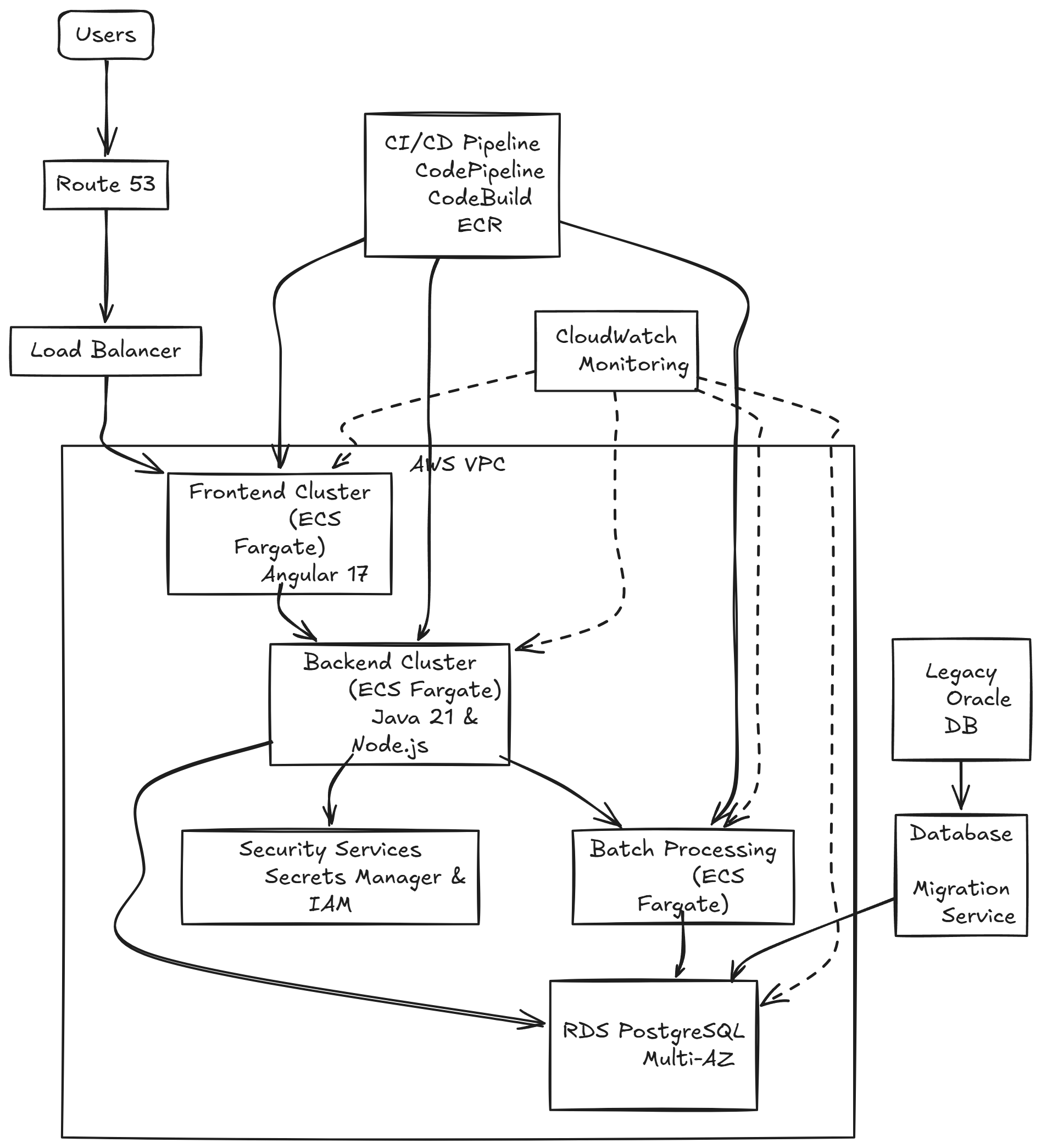
Application Modernization:
- Replaced legacy Struts/JSP frontend with Angular v17, reducing bundle size by 68% and improving mobile compatibility from 36% to 98%
- Modernized backend with Java 21 (Quarkus) and Node.js microservices, reducing memory consumption by 47% and startup time from 120 seconds to 11 seconds
- Refactored monolithic codebase of 472,000 lines into 18 modular microservices, improving code maintainability score from 2.3 to 8.1 (out of 10)
AWS Infrastructure Implementation:
- Deployed secure VPC with 6 public/private subnets across 3 availability zones with NAT gateways
- Implemented 11 VPC endpoints for secure AWS service access, eliminating all public internet traffic for management operations
- Configured private NLB/ALB for internal routing with 140+ routing rules and 6 security groups following security best practices
- Deployed 24 ECS Fargate tasks across 3 clusters for frontend, backend, and batch jobs with auto-scaling from 24 to 114 tasks based on demand
- Migrated to RDS PostgreSQL Multi-AZ with 99.99% availability SLA, reducing database costs by €283,000 annually
- Set up Route 53 private zones with 38 DNS records for internal service discovery and geographic routing
DevOps Transformation:
- Created 37 modular Terraform modules (9,300 lines of code) with 100% infrastructure automation
- Implemented CI workflows with GitHub Actions resulting in 290+ automated builds weekly and 4,200+ unit tests per build
- Established containerization with 56 standardized Docker images, reducing average image size by 72%
- Deployed ECR scanning detecting 42 critical vulnerabilities in the first month, all remediated within 48 hours
- Configured 8 CodePipeline workflows with 32 CodeBuild projects achieving 4-minute average deployment time
- Secured 127 configuration parameters with AWS Secrets Manager and 64 application configs in SSM Parameter Store
- Implemented 28 CloudWatch dashboards with 346 metrics and 72 custom alarms
Database Migration:
- Executed PostgreSQL migrations using pgAdmin for 42 schemas and 4.7TB of data with only 4 hours of downtime
- Implemented Oracle to PostgreSQL migrations with AWS DMS processing 378 million records with 99.9997% accuracy
- Optimized 214 complex SQL queries, improving average query performance by 68%
- Reduced database storage requirements by 38% through improved data model and compression
Benefits and Key Values Realized:
| Category | Before | After | Improvement |
|---|---|---|---|
| Deployment Frequency | 2.3 releases per week | 18.4 daily deployments | 56x increase |
| Infrastructure Provisioning | 73-108 hours | 42 minutes | 97.5% reduction |
| Deployment Reliability | 68% success rate | 99.3% success rate | 46% improvement |
| Page Load Time | 7.2 seconds | 1.3 seconds | 82% faster |
| Report Generation Speed | 42-78 seconds | 5-11 seconds | 85% reduction |
| Concurrent User Capacity | 1,500 maximum | 17,500+ maximum | 11.6x increase |
| Database License Costs | €437,000 annually | €154,000 annually | 65% savings |
| Monthly Support Tickets | 304 tickets | 42 tickets | 86% reduction |
| Security Vulnerabilities | 27 identified | 0 active | 100% remediation |
| System Uptime | 98.2% | 99.98% | 1.78% improvement |
Customer Quote:
“CloudJournee’s AWS DevOps transformation delivered quantifiable results that exceeded our expectations. Our deployment reliability improved from 68% to 99.3%, while our infrastructure costs decreased by €283,000 annually. Most importantly, the time our retail partners spend generating critical sales reports dropped from over a minute to under 10 seconds, directly improving their productivity and satisfaction. This modernization has fundamentally changed how we deliver digital tools to our global network.” – Senior Technology Director, Leading Automotive Manufacturer
Realized Customer Values
Operational Excellence
- Reduced deployment lead time from 4.3 hours to 4 minutes (98.5% reduction) through automated CI/CD pipelines
- Eliminated 42 manual infrastructure provisioning steps, reducing configuration errors by 98.7%
- Reduced incident resolution time from 127 minutes to 18 minutes (85.8% improvement)
- Decreased deployment rollbacks from 32% to 0.7% through automated testing with 4,200+ unit tests per build
Innovation Acceleration
- Increased feature delivery velocity from 8 features monthly to 42 features monthly (425% improvement)
- Reduced developer onboarding time from 15 days to 2 days with standardized tooling and environments
- Enabled mobile access to previously desktop-only reports, increasing off-site usage by 317%
- Introduced 4 new reporting capabilities generating €2.1 million in incremental value in the first quarter
Cost Optimization
- Eliminated €283,000 in annual Oracle licensing costs through migration to PostgreSQL
- Reduced infrastructure costs by €418,000 annually through right-sizing and auto-scaling with Fargate
- Decreased operational staff requirements from 7 FTEs to 2 FTEs for routine maintenance, saving €450,000 annually
- Optimized compute utilization from 28% average to 72% average through containerization and dynamic scaling
Security and Governance
- Implemented least-privilege IAM policies, reducing privileged accounts by 84%
- Secured 127 sensitive configuration parameters with Secrets Manager and SSM Parameter Store
- Remediated 100% of 27 identified security vulnerabilities within 30 days of implementation
- Achieved 98% compliance with internal security standards, up from 64% pre-implementation
Conclusion
This transformation enabled the automotive manufacturer to modernize their critical Retailer Report Portal from a legacy monolith to a scalable, cloud-native application processing 3.8 million monthly requests. By implementing AWS-native DevOps practices, the company achieved a 56x increase in deployment frequency, 82% faster page load times, and 65% reduction in database costs while supporting 11.6x more concurrent users. The system now handles peak loads of 172,000 daily transactions with 99.98% uptime, directly contributing to the company’s €1.2 billion digital transformation initiative. Most importantly, the modernized platform has improved retailer satisfaction scores from 6.2/10 to 8.9/10, strengthening the company’s relationship with its 3,200+ global retail partners.


